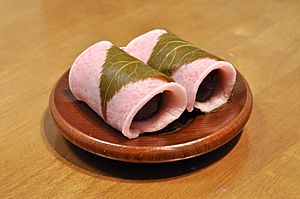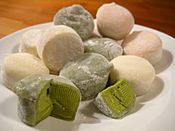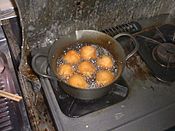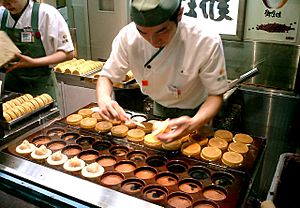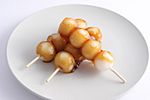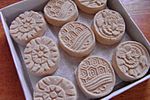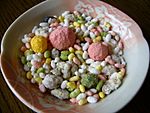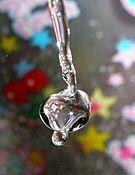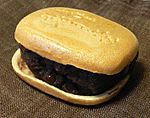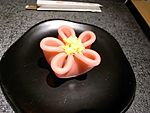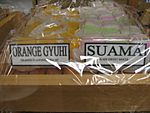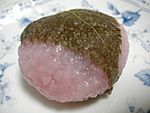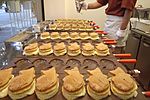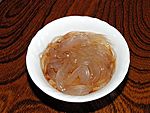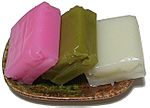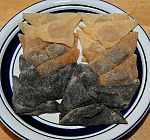List of Japanese desserts and sweets facts for kids
Japan has been making delicious desserts for hundreds of years, long before sugar became easy to find! Many of the sweet treats you see in Japan today have a very long history. In Japanese cuisine, traditional sweets are called wagashi. These are often made with ingredients like red bean paste and mochi (a type of rice cake). While many desserts date back to the Edo period (1603–1867) and Meiji period (1868–1911), Japan also has many new and modern sweets.
It can sometimes be tricky to decide what counts as wagashi and what doesn't. For example, kasutera (castella) cake came from Portugal over 400 years ago. But it was changed to fit Japanese tastes, so now it's considered a wagashi! The raindrop cake, which was invented in 2014, was created by a wagashi shop. It's a spin-off of shingen mochi and is also seen as a wagashi in Japan. Lately, wagashi shops have even started mixing traditional wagashi with Western sweets, creating "neo-wagashi."
Contents
Popular Japanese Desserts
Japan has many yummy desserts that are loved by people of all ages. Here are some popular ones you might find:
- Anpan (a sweet bun with red bean paste)
- Chinsuko (Okinawan cookies)
- Coffee jelly (a jiggly dessert made from coffee)
- Green tea ice cream (ice cream flavored with matcha)
- Hakuto jelly (a clear jelly made from white peaches)
- Melonpan (a sweet bun with a crispy cookie crust)
- Mochi ice cream (ice cream wrapped in soft mochi)
- Purin (a creamy custard pudding)
- Sata andagi (Okinawan fried doughnuts)
- Tokyo banana (a sponge cake with banana cream filling)
-
Hakuto jelly is a seasonal dessert in Japanese cuisine available in the summer.
-
Mochi ice cream is a Japanese confection made from mochi (pounded sticky rice) with an ice cream filling.
-
Sata andagi are sweet, deep fried buns of dough similar to doughnuts
What are Wagashi?
Wagashi (和菓子) are traditional Japanese sweets. They are often served with tea, especially during a Japanese tea ceremony. Many wagashi are made from plant-based ingredients like mochi, anko (azuki bean paste), and fruits.
Wagashi come in many different shapes, textures, and flavors. They are made using various ingredients and cooking methods. Wagashi are popular all over Japan, and each region often has its own special kinds. Some wagashi are only available during certain seasons.
Different Kinds of Wagashi
There are many types of wagashi, each with its own unique taste and look. Here are some examples:
- Akumaki
- Amanattō
- Amezaiku
- Anmitsu
- Arare
- Botamochi
- Beika
- Castella
- Chitoseame
- Daifuku
- Dango
- Dorayaki
- Gionbō
- Gyūhi
- Hanabiramochi
- Higashi
- Hishi mochi
- Imagawayaki
- Kanten
- Karintō
- Karukan
- Konpeitō
- Kusa mochi
- Kuzumochi
- Keiran Sōmen
- Manjū
- Mizuame
- Momiji manjū
- Monaka
- Namagashi
- Nerikiri
- Raindrop cake
- Red bean paste
- Sakuramochi
- Senbei
- Shiruko (red bean soup)
- Suama
- Taiyaki
- Tokoroten
- Uirō
- Warabimochi
- Wasanbon
- Yatsuhashi
- Yōkan
- Yubeshi
Wagashi Gallery
-
Daifuku is a glutinous rice cake often filled with sweet anko.
-
Dango is a sweet dumpling made from rice flour, similar to mochi. It's often served with green tea.
-
Higashi are dry sweets with very little moisture, so they last longer than other wagashi.
-
Arare are small Japanese crackers made from glutinous rice and flavored with soy sauce.
-
Hanabiramochi is a Japanese sweet usually eaten at the beginning of the year.
-
Monaka has an azuki bean jam filling sandwiched between two thin, crispy wafers made from mochi.
-
Namagashi are a type of wagashi often used in the Japanese tea ceremony. They can contain fruit jellies or sweetened bean paste.
-
Dōmyōji has sweet pink mochi and red bean paste, covered with a cherry blossom leaf.
-
Uirō is a traditional Japanese steamed cake made of rice flour and sugar.
-
Warabimochi is a jelly-like sweet made from bracken starch. It's often covered in kinako (sweet toasted soybean flour).
-
Assorted yatsuhashi. The flavors, from top to bottom, are tofu, cinnamon, and sesame.
See also


